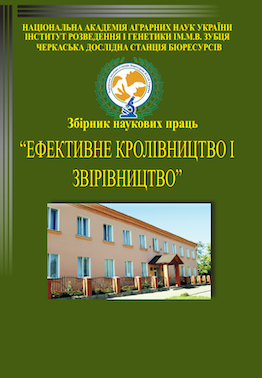PRODUCTIVE ACIDFUL ACTION OF FEED ASID STAG S BF ON GROWTH INTENSITY AND FUNCTIONAL STATE THE ORGANISM OF THE YOUNG KILLS FOR THE INTENSIVE BREEDING OF MEAT
DOI:
https://doi.org/10.37617/2708-0617.2020.6.74-88Abstract
The studies were conducted at the Carpathian State Agricultural Research Station. The farm uses developed technology of intensive production of rabbit. The genotype of farm-bred rabbits is three breeds of white giant, chinchilla and flinders (NTSH).
For the experiment, by the method of pair-analogues, 5 groups of young rabbits of 15 heads in each were formed. The first control group was fed feed without acidification, 2, 3, 4 and 5 experimental groups with a content of 0.1; 0.3; 0.5; 0.7% of acidifying feed Asid Stag S BF.
The maximum live weight of one head at 90 days of age was in the 4th experimental group, amounted to 2,967kg where the acidifier of feed ASID STAG S BF in the amount of 0.5% was used, while, when using this acidifier in the diet of feeding young rabbits 2nd of the group (0.1%) was - 2,877 kg, of the 3rd group (0,3%) - 2,89 kg, and of the 5th (0,7%) - 2,9 kg.
The average daily increments for the period of 40-90 days were higher in the fourth experimental group (0.5%) - 42.1 g, slightly lower when using the acidifier ACID STAG S BF in the diets of pre-study groups of rabbits: 2nd (0.1 %) - 40.2 g; 3rd (0.3%) - 40.6g; and 5th (0.7%) - 40.9g.
Measured lifetime indicator - the width of the waist at 3 months of age in the rabbits of these groups was 5.9 cm, in the 2 and 5 groups, when introduced into the diet of
experimental rabbits acidifier feed ASID STAG S BF in the amount of 1 kg and
respectively 7 kg per ton ready feed this figure is 5.8 cm.
Feed costs in 1-, 2-, 3-, and 5 groups were 3.55; 3.48; 3.4 kg and 3.41 kg of
finished feed per 1 kg of increase, while in group 4, they were somewhat more effective and found at 3.32 kg.
The best indices of fattening productivity with the introduction of 5 kg of acidifier feed ASID STAG S BF per tonne of prepared feed (experimental group 4) were obtained due to the efficiency of physiological influence of low molecular weight organic acids on the digestion process of mono-gastric, herbivorous rodents, which was manifested in the better feed. At the same time the fattening indices of the 4 experimental groups increased to 1 rabbits: control weight at 90 days of age, 190 g; average daily gains of 3.9 g; width across 0.2 cm; improved feed conversion by 230g
Reduction of the cost of feed per 1 g of increase to 1 control group (2485 UAH), occurred to 4 groups: 2 experimental 2464 UAH; 3 experimental 2461грн, 4 experimental 2457грн. The cost of feed in the cost structure of the 5 experimental group was the highest - 2578UAH. Such dynamics had an impact on net profit and profitability.


